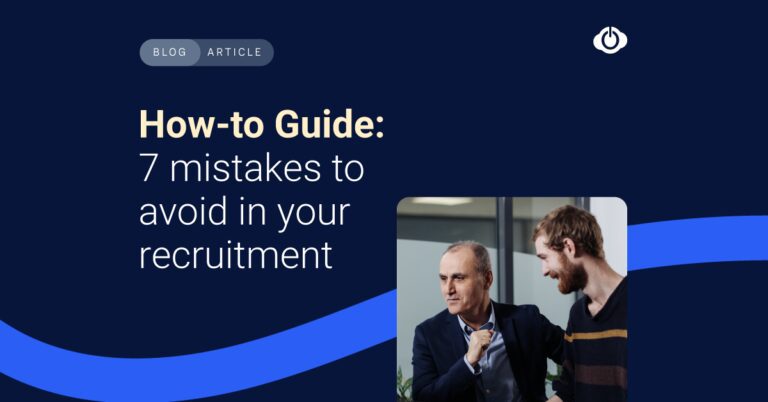7 Mistakes to Avoid in Your Recruitment: How to Fix Them
Hiring new employees is a significant investment for any company, and a bad hire can have costly consequences. To help you avoid common pitfalls, here are seven recruitment mistakes you should avoid—and how to fix them.
What Makes a Good Recruitment?
A good recruitment process is structured and focused, ensuring the right candidate is hired for the right role. It begins with a clear recruitment plan, identifying the company’s needs and crafting a detailed job description.
Job advertisements should target the most effective channels to reach your audience, and applications should be screened systematically to shortlist the most qualified candidates.
Structured interviews and professional follow-ups with clear feedback create a respectful and efficient process. Additionally, a recruitment system can be invaluable in streamlining critical steps and freeing up resources for other tasks.
Even with a solid plan, unexpected challenges may arise. Instead of ignoring these, learning from them and using the experience to strengthen future processes is essential.
You might also like: Choosing the Right Onboarding Software: 6 Key Features You Need
7 Mistakes to Avoid in Your Recruitment
Here are seven common mistakes to avoid, along with insights from HR-ON’s CEO, Ali E. Cevik, on how to handle them:
1. Losing Track of the Process
Create a tailored recruitment plan to avoid wasting valuable time. A well-structured plan helps you set and stick to deadlines for job postings, interviews, and start dates, ensuring you stay on schedule and meet commitments.
2. Using Clichés in Job Ads
Phrases like “must juggle multiple tasks” or “thrives in a fast-paced environment” are overused and often taken with a grain of salt by job seekers. Instead, think outside the box and craft a unique job posting that reflects your company’s authenticity, boosting both credibility and interest in the role.
3. Sticking to the Same Habits
According to Ali E. Cevik, we often gravitate towards hiring people who resemble ourselves. He encourages hiring managers to break this habit by exploring new perspectives—consider techniques like blind recruitment or advertising on unconventional platforms. Unique job postings discourage generic applications, prompting candidates to engage more thoughtfully with your ad.
4. Asking for Too Much
Be specific about what you’re looking for in a candidate. Clearly outline your values, workplace culture, and job responsibilities in the job posting. Avoid contradictory requirements, such as expecting someone to be analytical and outgoing or creative and highly structured. Instead, clarify whether you’re seeking a recent graduate, an experienced professional, or someone with a specific certification.
5. Overwhelming Your Inbox
Receiving hundreds of applications via email can quickly lead to chaos, making it hard to manage and systematize responses. A recruitment system like HR-ON Recruit can automate tasks like application management, confirmation emails, interview scheduling, and rejection letters. This streamlines your recruitment process, allowing you to focus on evaluating candidates and conducting interviews.
6. Overlooking Hidden Gems
Even if you’ve clearly stated what you’re looking for, you may receive applications from unconventional candidates. Give these individuals a chance—they might bring fresh perspectives, innovative solutions, or unexpected skills. Embracing diversity and breaking out of traditional hiring molds can lead to growth and inspiration within your team.
7. Forgetting Your Company’s Values
HR-ON’s recruitment system emphasizes value-based recruitment, a concept we encourage our clients to adopt. By consistently communicating your company’s core values throughout recruitment, you help candidates understand what your organization stands for. This alignment increases the likelihood of long-term hiring a genuinely dedicated employee who fits your company culture.
Ready to Enhance Your Recruitment?
Start by identifying potential mistakes in your current recruitment process and addressing them. Recruitment challenges are inevitable, but they can provide valuable learning opportunities. Your recruitment system should work seamlessly to support the process without adding unnecessary hurdles.
Learn more about what our customers say about us or explore how HR-ON Recruit can enhance your recruitment efforts with tools like Recruitment Analytics and a custom career page.
Recruitment requires time and effort, but finding the right candidate is worthwhile. Welcoming a new team member is a pivotal moment for both the employee and the company, underscoring the importance of a well-executed recruitment process.
FAQ: What Is a Recruitment?
What are the biggest challenges in recruitment, and how can they be addressed?
Clear criteria, structured interviews, and data-driven insights from recruitment systems can help tackle challenges such as finding qualified candidates or avoiding bias.
What is the purpose of a recruitment process, and why is it important for companies?
The purpose is to find the right candidate for a role that aligns with the company’s needs and culture.
What are the typical steps in a recruitment process?
Key steps include identifying needs, creating a job description, advertising, screening candidates, conducting interviews, making a selection, and following up.
How can a recruitment system improve the process?
A system like HR-ON Recruit can automate administrative tasks, provide better candidate management, and enhance communication, saving time and resources.


